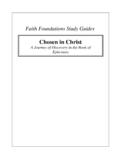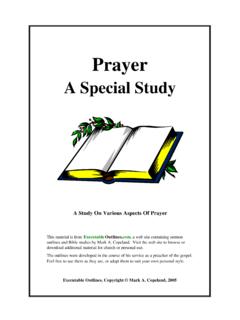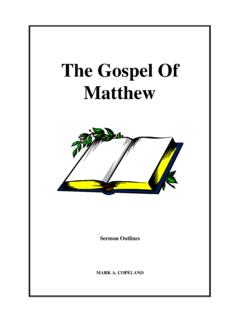Transcription of The Book of Revelation Bible Study Material
1 The Book of Revelation Bible Study Material Mark Brighton Copyright 2008 Mark Brighton All rights reserved ii Preface This Bible Study is designed to highlight the major points of Revelation in eight weeks. I encourage you, the participant, to maximize your learning by working through the Study questions for each week prior to coming to class. These questions are not designed as a test of your knowledge and should not be treated as such. Instead, they are provided to help you begin to ask important questions about the interpretation and contents of Revelation . We will focus on each of these questions when we gather together. You will also find questions for personal reflection at the end of each session. They are open ended questions which have no right or wrong answers and are designed to help you meditate and pray about how the contents of Revelation apply to your life.
2 I encourage you to bring your insights to class to share with others. There is perhaps no more misunderstood book of the Bible than Revelation . Yet it has a clear message for all who would devote themselves to its pages. May God bless our Study of His Word! iiiBible Study Outline ii Simplified Outline for Revelation .. 1 Outline of Revelation with 2 Session 1: How To Read and Understand Revelation . - Chapter 1 .. 8 Session 2: Christ s Letters to the Church and the Inaugural Vision (chaps. 2-5) .. 10 Session 3: The Seals Christ s People Preserved (chaps. 6:1-8:1) .. 12 Session 4: The Trumpets Christ s People Witness (chaps. 8-11) .. 14 Session 5: The Book Interlude Christ s People Victorious over Evil (chaps. 12-14).. 16 Session 6: The Bowls and the Last Judgments The Cosmic Exodus (chaps.)
3 15-19).. 18 Session 7: The Kingdom of Christ and Satan s Doom (chap. 20) .. 19 Session 8: The New Heaven and Earth (chaps. 21-22).. 20 Notes .. 21 Further 22 1 Simplified Outline for Revelation I. Introduction A. The Prophet is Commissioned 1. The Prologue (1:1-8) 2. The Commissioning Vision (1:9-20) B. The Seven Letters (2:1-3:22) C. The Inaugural Vision (4:1-5:14) II. The Prophecy A. The First Cycle of Seven: The Seals 1. Seals 1-6 (6:1-17) 2. Interlude: Christ s People Preserved (7:1-17) 3. Seal 7 (8:1-5) B. The Second Cycle of Seven: The Trumpets 1. Trumpets 1-6 (8:6-9:21) 2. Interlude: Christ s People Witness (10:1-11:14) 3. Trumpet 7 (11:15-19) C. Book Interlude: The Cosmic Struggle Between Christ and Satan (12:1-14:20) D. The Third Cycle of Seven: The Bowls (16:1-21) III.
4 The End: Close-up A. Judgment and Overthrow of the Forces of the Dragon (17:1-18:24) B. Victory Celebration (19:1-21) C. The Judgment and Overthrow of the Dragon (20:1-10) D. The New Heaven and Earth (20:11-22:5) IV. Epilogue - The Promise of Christ's Coming (22:6-21) 2 Outline of Revelation with Notes I. Introduction A. The Prophet is Commissioned 1. The Prologue (1:1-8) John calls his letter the Revelation of Jesus Christ. It is from Jesus Christ but is also about Jesus Christ. The primary purpose of Revelation is to reveal Christ and not to satisfy curiosities about the four horsemen, the Antichrist, etc. Its purpose rather is to show how Christ has received all glory and dominion in heaven and earth and how he controls all things for his good and gracious purposes until his glorious appearing at the last day.
5 That is, whereas in the Gospels Jesus did nor always or fully use his divine power and glory (his state of humiliation), in Revelation he makes full use of it (the state of exaltation) to limit/conquer evil, to protect his people and give them His victory, and to bring in a new heaven and earth. Revelation falls under the literary genre called apocalyptic, which is characterized by the presentation of visions and heavy use of symbolic language. First century Christians of Asia Minor, those to whom John wrote, would recognize many of these symbols and images from their Scriptures, and so we also will regularly turn to the Old Testament when interpreting the contents of Revelation . This is true right away with the phrase the seven Spirits of God, which in light of Is.
6 11:1-3 is most naturally understood as the Holy Spirit, who brings the seven-fold gifts of God. The time is near! This is a regular theme of the latter days. See also Matt. 24:36-44 and 1 Thess. 5:1-11. Though God s people do not know when Christ will return, through faith in Christ they are always ready and will not be taken by surprise. The seven churches are all located in Asia Minor along Roman roads. The Concordia Self- Study Bible has a map on page 1948. As with the letters of Paul, the message is not only to these seven but to all God s people. 2. The Commissioning Vision (1:9-20) Similar to Ezekiel (chapter 2) and Isaiah (chapter 6), here John is commissioned as a prophet. John turns and sees one like a son of man. This messianic title goes back to Daniel 7:13-14, where Daniel sees in a vision how this person, worthy of divine worship, receives from God all glory, power, and dominion.
7 This son of man thus establishes an everlasting kingdom. This was the messianic term which Jesus regularly applied to himself. See Mark 14:61-62. Revelation reveals how Jesus, the exalted Son of Man, exercises his authority throughout the end times and finally establishes his glorious kingdom in the new heaven and earth. This is the only complete description of Christ in all his glory, but it is a theological description. Note, for example, where Christ stands; in the midst of the lampstands (the churches). See Matt. 18:20. B. Prepare to Receive the Prophetic Message (Letters to the seven churches, 2:1-3:22) The letters prepare us for the message of Revelation and for the suffering to come. Each follows a standard format: addressee, description of Christ, "I know", good identified (except Sardis and 3 Laodicea), sins/failings identified (except Smyrna and Philadelphia), "Whoever has an ", a Gospel promise.
8 C. The Inaugural Vision of Heaven 1. The Vision of the Throne of God and Heavenly Court (4:1-11) 2. The Sealed Scroll and the Lamb Worthy to Open It (5:1-14) This is a two-part vision, where God is praised as creator (chapter 4) and Christ as powerful Redeemer (chapter 5). The message of chapter five cannot be over emphasized. All the events of Revelation /the end times, here represented as the sealed scroll, fall under the mighty power of the Lamb. See Romans 8:28f. This constitutes an important message to the persecuted. II. The Prophecy The prophecy is organized into three cycles of seven, with an interlude between the second and third cycle. This suggests that we should not interpret Revelation in a linear fashion, especially since the end of the world is described in chapters 6, 11, 14, 16, and 20.
9 Revelation , instead, presents repeated overviews of the end times. The first two cycles, the seals and the trumpets, also have interludes between the next to the last and last items. Any unmatched items in such a structure tend to receive the emphasis. Thus, the primary emphases in the first two cycles are that God preserves his people (the interlude of the first cycle) and that the God's word is still proclaimed (the interlude of the second cycle). The primary emphasis, the heart, of the book is chapters 12-14. Each cycle describes what occurs repeatedly throughout the latter days, the time from Pentecost to the end. For when the latter days occur see Acts 2:17, 1Ti 4:1, 1 Jn 2:18. We should expect that the events described here will escalate as the end draws near.
10 See Mt 24:8,12; 2Ti 3:1. A. The First Cycle of Seven: The Seals - Tribulations among mankind. 1. The First Four Seals: The Four Horsemen (6:1-8) 2. The Fifth Seal: Suffering of the Saints (6:9-11) 3. The Sixth Seal: The End and Its Terror Described (6:12-17) 4. Interlude: God's People Preserved in Suffering (7:9-17) a. The 144,000: The Church Militant b. The Heavenly Multitude: The Church Triumphant 5. The Seventh Seal: Introduces the Second Cycle (8:1-5) The horsemen are a matched set, and inasmuch as the last one is identified not as a person but as death (6:8), we should probably not interpret the prior three as individuals either. These horsemen symbolize tyranny, warfare, economic upheaval/famine, and death. The fifth seal answers for how long and why God's people suffer.









